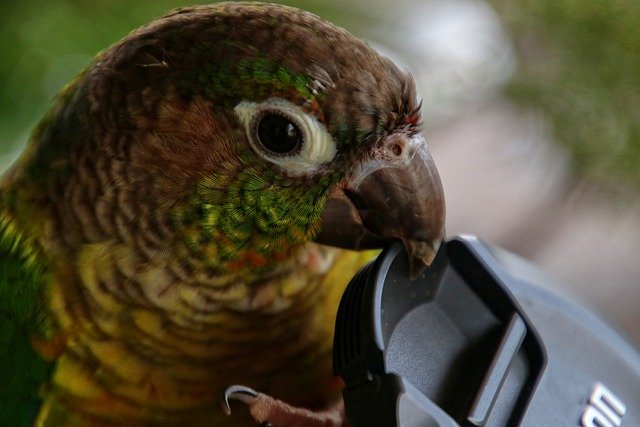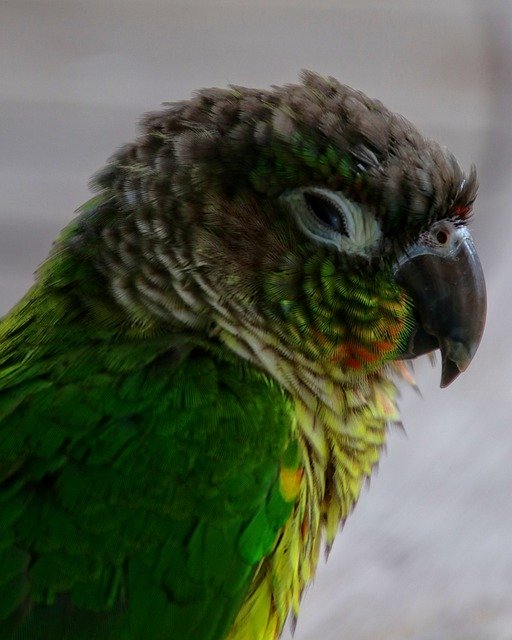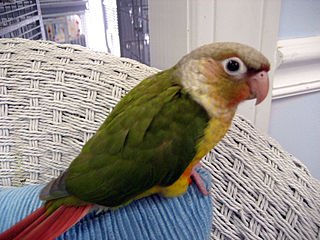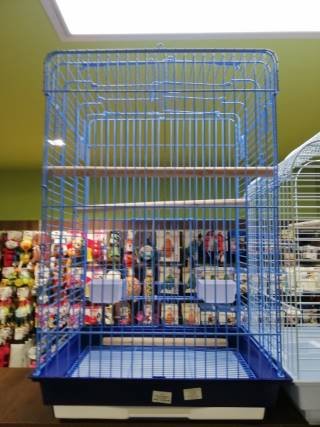Green cheeks can be kept peacefully in several settings, including apartments, and houses, as family pets, and as pets for both inexperienced and experienced bird owners.
When shopping for a parrot, or any pet, you should prepare a list of the personality traits you want in your pet.
Many people desire a pet that is affectionate, playful, intelligent, and curious, among other characteristics. Green cheeks have all of these characteristics!
Let’s take a deeper look into their behavior:
Cuddliness
Like their larger cousins, the macaws, Green Cheeks are often quite cuddly. I believe the infamous cockatoos only surpass the parakeet/macaw group in terms of cuddliness! However, like all of these species, especially green cheeks, it highly depends on the individual.
Most green cheeks enjoy having their heads and necks scratched; many also enjoy being petted all over their body, and some will even let you rub their bellies if you turn them on their backs.
However, some animals will only accept snuggling and stroking on their terms, and they may not desire it as frequently. Some birds would prefer not to be touched at all. However, this is an exception!
Playfulness
Green cheeks like playing! Toys can be store-bought or handcrafted, and they can be something you would never think of as toys!

Green cheeks prefer to chew, climb on and hang from items, and some like to climb into and examine things like boxes, paper bags, even your sleeve! Green cheeks enjoy playing with you and initiating their games. “I drop it, you get it!” is a popular game.
Like puppies, young green cheeks wrestle with each other or with you. Some people carry on like this throughout adulthood.
Curiosity
Green cheeks can be a peculiar mix of outgoing and curious and flighty and phobic. This is heavily influenced by how they were reared. Green cheeks, which have been well-socialized, are frightened of nearly nothing and would love to travel anywhere and do anything with you. Many enjoy meeting new people!
Intelligence
Green cheeks have a lot of intelligence, which is difficult to define. They may be a bit less intellectual than the truly giant parrots, and this varies significantly by individual, but most can keep up with any medium or medium-sized parrot.
Their “obedience intelligence” is quite good, like with other parrots, and they can be taught simple tricks reasonably readily, more intricate skills with some effort.
Another reason for their popularity is their modest size. Their wit, knowledge, and calm demeanour contribute to their allure. They are friendly tiny birds that require attentive and loving care from their owners.
Conure most common problems
So far, green cheeks sound pretty fantastic, but like with any pet, there is a disadvantage, or several disadvantages, if you want to be particular.
These can be reduced with careful treatment and socializing, and some Green cheeks have just benefits and no drawbacks! However, here are a few of the most common problems:
Aggression
The most prevalent behavioral problems of green cheek owners are nipping and biting. As I mentioned, they have prominent personalities, and when they get their way, they go all out! The worst-case scenario involves birds who have decided that humans are only useful for biting and bossing around – they will sit in their cages and attack any hand that comes within touching distance of them.”
Fortunately, these birds are scarce! There are exceptions, but as far as I know, most of these genuinely awful cases are birds from pet stores that weren’t sold straight away, and I eventually learned that a few well-placed pinches could get rid of all those pesky fingers caught in their cages.
Aggression can manifest itself in many other situations and to varying degrees, and listing them all would be a FAQ in and of itself! I’d say that the average green cheek bites only in a couple of situations: when it’s perched on your shoulder or when it’s jealous of another human or animal.
Aggression isn’t a significant deal for the typical green cheek, and it’s easy to avoid situations where it might bite.
Fearfulness:
Just because a bird is prone to violence does not imply it will not flee in terror the next time! In birds, I tend to divide fear into two categories: The fear of nearly everything unusual is known as general fear. It is widespread in birds that have not been adequately socialized.
They may be terrified of meeting new people, going to new locations, and having new experiences. It is pretty simple to prevent widespread fear in your bird: socialize it well. “Curing” them later in life takes more time but is possible. Object anxiety is more innate.

It’s considerably more common in small birds than larger ones, and it’s also true for green cheeks. It is a dread of specific objects, people, animals, and most notable predators such as cats or dogs.
Fear of objects, balls being flung around, or anything being swung aloft is frequently caused by balloons. Anything large or bright moves are frequently the source of the green cheek’s dread.
Most green cheeks are terrified of a few objects like this, and it is typically advisable not to bring these things near the bird!
Destructiveness:
All parrots are destructive to some extent, for the same reasons as tiny children: they are curious, don’t know any better, and have tools that allow them to destroy! (Hands for kids, beaks for birds!
On the other hand, green cheeks are less destructive than most other parakeets since their beaks are smaller and lack the same power. They still enjoy nibbling on whatever they can!
You can’t be furious with a bird for chewing the edge of the trim on your great-antique grandmother’s dresser: he was doing what he was trained to do, and he shouldn’t have had access to the furniture in the first place.
He’s lucky he’s not a cockatoo, or he would have bitten the legs!
Green cheeks chew on wood, paper, and anything else that their beak can demolish. If you don’t want anything eaten on, don’t let the bird chew on it!
What’s the deal with my Conure head wagging?
They have many endearing features. They enjoy scratching their owners’ heads or burying themselves in their owners’ clothes, jackets, and sweaters. This bird is also noted for bobbing its head.
The birds are ecstatic.
When your bird is delighted to see you after a long day at work or on vacation, it will swiftly bob its head up and down in happiness.
Furthermore, the bird may attempt to speak or create high-pitched whistling sounds. This quick head movement indicates that the parakeet is pleased to see you.
They will also bob their heads when they are enthusiastic about something, such as food or a favourite pleasure. When they hear music, most parakeets are delighted as well.
They may begin to dance while bobbing their heads. This is typical if you haven’t seen your pet in a while.
Is it true that two birds are happier together and require less attention than one bird?
This question can only be answered in one of two ways! There are only a few instances where this works out perfectly: The two birds become companions and keep each other company. They don’t require as much attention, but they remain tame and affectionate when you have time to care for them.
But those are the exceptions, and they are few and far between! There are two further possibilities. First, the two birds realize they genuinely like each other, and the owner makes the rookie error of putting them in the same cage together.
The birds enjoy it, but they rapidly realize they no longer require the owner’s care; they become hostile or fearful and cannot be handled.
The second option is that the two birds despise each other: The first is envious of and hostile toward the newcomer in many circumstances. The owner must keep the two birds apart and cannot even let them out of the cage simultaneously: This means that the owner must devote twice as much attention to them as they would to a single bird!
Most households with two (or more) birds fall into the third group, where the birds are kept apart yet get along well enough to be let out of their cages together to play and socialize.
Even though they love each other’s company, they demand more time and individual attention from their owner than a single bird. Even if you have more than one bird, you shouldn’t cut back on your time spent with them.
A pair of birds who don’t need or want your attention is the only exception. They won’t be kind and friendly pets, but they can be exciting and entertaining family members. And if they are male and female and you can supply them with the proper environment, they may even lay eggs and have babies for you.
Are Green cheek conure noisy?
Parakeets are known to be among the noisiest parrots. This is true in the case of larger parakeets! Smaller pyrhurra parakeets, such as green-cheeked parakeets, are quieter. Please pay attention to the word “relatively!”
Green cheeks make their noises, which are primarily squeaks and squawks. While these are pretty quiet compared to their louder cousins’ thunderous shrieks, some individuals find them unpleasant.
It should also be emphasized that noises are a unique feature of green cheeks, with some continually calling out to their owners and others virtually always silent.
Green Cheek Conure Talking ability
Green cheeks are not thought to be good conversationalists. If they speak at all, most green cheeks say very little, in my opinion. Furthermore, they have soft and gravelly voices, so even if they try to speak, they may not be able to say anything understandable!
However, there are a few green cheeks who talk a lot. They are also intelligent little birds, and if you communicate to them in context, they will frequently learn to speak in context as well (e.g., “good night” at night, “hello” when they greet you).
Are Green Cheek “one-person birds?”
Let’s start with a look at parrots’ natural social environment. Parrots are herd animals, which means they continuously interact with their group of familiar friends and relatives.
They are, however, monogamous, which means they have a single partner with whom they desire to snuggle and be close.
Captive-bred parrots follow this pattern. Most parrots have a “favourite” person they like to spend time with.
Usually, this person takes the most care of them. Still, the bird may have a favourite person for other reasons (often because one feels more comfortable and secure interacting with it).
If this favourite person is the only one who cares for the bird, Because the parrot is unfamiliar with other people, it is very likely to become a one-person bird. Socialization is the key to preventing a one-person bird.
On a daily basis, it’s likely that the bird may come into contact with a wide range of people as well as strangers or other new acquaintances.
All of this applies to any parrot. Green-cheeked parrots are less likely to become one-person birds than other parrots, such as Poicephalus parrots or African grey parrots.
Are Green Cheek Conure nippy?
Green-cheeked parrots are known to be aggressive birds. To a certain extent, this reputation is warranted. Biting or aggressive behaviour is the most common behavioural complaint with green cheeks, in my opinion.
Some green cheeks will never bite a human. Most green cheeks rarely bite, but they may do so at certain times of life or under certain conditions.
Unfortunately, a few green cheeks are highly aggressive and bite frequently. It is determined by the individual and how they were reared and socialized.
Understanding your bird’s general everyday behaviours also helps alert you when something doesn’t feel quite right.
The following are normal, good and healthy observations.
How do they differ from other parakeets in their behaviour?
Green-cheeked parakeets have a spikier personality than larger parakeets. They remind me of terriers in size but with a lot of personalities! They are also more aggressive than some of their more laid-back larger cousins, similar to terriers.
There are minor personality differences among the Pyrrhura.
The average green-cheeked parakeet is comparable to the average Chestnut-bellied, black-headed, or colorful parakeet. Individual differences are considerably more visible than species differences here!
How do they stack up against other parrots?
Although I like smaller birds, green cheeks are cleverer and more interactive than cockatiels, budgies, or lovebirds.
They have a “large bird personality,” which indicates they are a “big bird personality”! However, this can be a problem because it indicates that green cheeks are more prone to behavioural issues and that it’s simpler to “screw them up” if they’re not treated properly.
Most people, especially rookie owners, have more than enough intelligence and personality (and behavioural problems) in their smaller birds, but green cheeks have a little extra!
On the other hand, Green cheeked birds lack the “large bird personality” of Amazons, Greys, Macaws, and Cockatoos. This makes them considerably more tolerable, especially in a typical home!
Many people have requested personality parallels between parakeets and Poicephalus (Poicephalus are the small African parrots – Senegals, Meyers, etc.).
It can be difficult to articulate this distinction since, while there is undoubtedly one, the descriptions are pretty similar on paper – both can be described as lively, active, forceful, affectionate, and so on.
However, I believe that Poicephalus are more dignified and compassionate and more independent thinkers. They have a calmer, softer disposition and voice.
Budgies have a more baby-like attitude, are more reliant, and have a “loud” disposition! They are roughly comparable to cats and dogs.
If you must choose between the two, I prefer to meet some of them.
The difference in personality is usually apparent, and most individuals immediately decide that they prefer one species over the other – much like cats and dogs!




